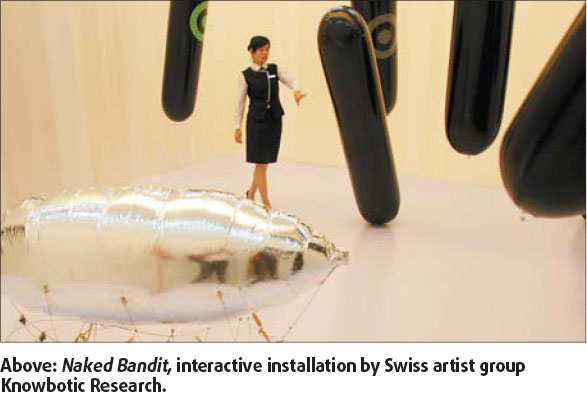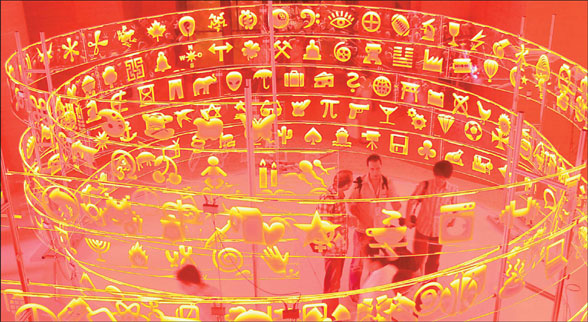Synthetic Times in real world
|
Vortex, LED installation by German artist Christoph Hildebrand. Photos by Jiang Dong |
When Li Yamei visited the Synthetic Times, the new media art exhibition occupying nine exhibition halls in the National Art Museum of China this week, it felt to her like entering a sci-fi world previously only encountered in movies and online games.
"It's great fun strolling through the museum and literally meeting the exhibits. I was really impressed with the incongruous-looking walking robot, talking prosthetic head, interactive videos and the airship that attacks visitors in dark clothing," says Li, from Shenyang, northeastern Liaoning province.
To Chen Mo, a media art major from Beijing, the exhibition "is definitely an eye-opener".
She was struck by the imaginative imagery of Yves Netzhammer's multimedia installation Subjectivasation of Repetition, and by Jeffrey Huang's Newscocoons - a fascinating computer-controlled simulacrum of inflatable furniture feeding on news. She was also impressed by Chinese artist Xu Bing's Book from the Ground, a chat room operating on pictographs and emotional icons rather than words.
Li and Chen are among the thousands who have visited the Synthetic Times Exhibition.
Various small-scale new media art exhibitions have been held in Beijing and Shanghai over the past few years.
The Shanghai eArts Festival, featuring new media art works, is slated for October, according to local media.
"But Synthetic Times is by far the most inspirational so far, as regards scale and content," Chen says.
"Each day, more than 3,000 visitors spend hours trying their hand at various media works, mostly interactive and participational," says museum dean Fan Di'an, adding that the exhibition is the largest ever held in any public museum.
The exhibition is one of several key Cultural Olympic events running until early July. It encompasses some 40 works by over 100 established and emerging new media artists from 30 countries and regions.
"This exhibition gives the general audience a concrete idea of what new media art means, and also brings them surprises and fun."
Arranged around the four distinct yet interrelated themes - Beyond Body, Emotive Digital, Recombinant Reality and Here, There and Everywhere, the exhibition addresses such issues as human identity; the relationship between man and technology; and art and technology in the new century, says Zhang Ga, a respected new media researcher and curator of the mammoth exhibition.
In the Beyond Body category is an interactive installation by Chinese artist Du Zhenjun, which confronts visitors with the ultimately macabre scenario.
It consists of a large screen to which half a table is affixed, projecting the ethos of an anatomy class. Eight doctors and one lifeless, prone body, all of identical appearance, play a game with visitors.
When a viewer approaches the screen, his or her presence is detected and he or she is invited to become an actor in the class. The doctors move in from the background and form a semi circle around the table in the foreground.
As long as the viewer remains where he or she is, the eight doctors continue to gaze at him or her in a clinically objective manner, as they did at the dead body. If the visitor moves away, the eight doctors also withdraw and return to the shadowy background of the animation.
One of the exhibits in the Emotive Digital category created by a group of Swiss artists titled Etoy has accommodated the specter of death within the digital age.
The artists have presented their Mission Eternity in a standard 20-ft shipping container carrying human mortal remains, concrete and LED matrix monitored by Linux software.
Net art pioneers Etoy, who have been developing Mission Eternity since 2005, present their latest project as the cult of the dead in the digital age of information technology. Mission Eternity deals with existential topics, such as the conservation and loss of memory, the future, the present and the past, and life and death. These topics are provocatively and brazenly transposed to the age of digital communication and information technologies.
New media artwork hit a cultural dimension in the form of a paper banknote printed with Chinese characters. It was handed by Etoy members to Chinese viewers, which is an aspect of rural burial rituals.
Dutch artist Marnix de Nijs actualized his impression of a rapidly changing Beijing in Beijing Accelerator, an interactive installation that visitors wait in line to sit inside and experience a breath-taking video game.
South Korean artist Kichul Kim's Sound Drawing in the Emotive Digital category is inundated with curious visitors drawing with a graphite pen that "sings" as it produced images.
One of the most eye-catching items in the Here, There and Everywhere category is Newscocoons.
It features a suite of pulsating furniture that displays news - user-generated videoclips, pictures, stories, and blogs - fed from geographically dispersed sources. The cocoons glow and breathe slowly. Each tracks a specific keyword (such as "body", "emotive", "recombinant", "alienation", and "reality") and aggregates related local content created on the Internet by both amateurs and professionals.
The spherical shape of Newscocoons is constantly in flux, varying according to the particular constellation and intensity of information flowing from various sources.
Each cocoon features an autonomous microchip and a touch-screen through which it senses the presence of hovering visitors that triggers incoming audio and visual news.
"Everyday, we are inundated with news coming from all angles. News emerges from the most unexpected places, in various multimedia formats, and at unpredictable times in an increasingly bottom-up, decentralized fashion, such as blogs, video stories, and picture books," explains Jeffrey Huang who cooperated with Muriel Waldvogel to create the artwork.
To add even further to the visitors' experience, Dutch designer Lars Spuybroek and his studio NOX have created an interface between a contemporary art form and the classical layout of the 45-year-old museum that is somehow reminiscent of the Dunhuang Grottoes facade. Viewers in certain exhibition halls are required to hike up steep slopes before they can sit and approach the media works on show.
Spuybroek and sound artist Edwin van de Heide have created a special installation in the main entrance to the museum where complex sound and architectural structures intertwine.
Passing and pausing visitors hear this basin of sounds juxtaposed with futuristic structures as they enter. Some look up or even lie down to listen. Others, obviously puzzled, use their fingers to block out the strange noise as they pass by.
"New media art is still a young aspect of the Chinese art scene. Not many Chinese artists have engaged in this field," Wu Meichun, a media researcher from Hangzhou, points out at a seminar at the museum. "And it is natural that the average audience should take time to enjoy it."
Most universities in China have either started courses on or acknowledged digital art or media art, according to Wu.
But in most cases, "video art and animation are synonymous with new media art. And most people doing new media art are mainly trained in visual arts removed from scientific and technological skills," Fan Di'an confirms.
With regards to overseas artists, however, "their works are often, if not always, the fruit of cross-disciplinary, collaborative endeavors. Their creative teams may include visual artists but also architects, computer specialists and experts from other fields," Fan explains.
"China's new media art is emerging. But it has a long way to go before it reaches maturity," Fan says.

(China Daily 06/17/2008 page18)















